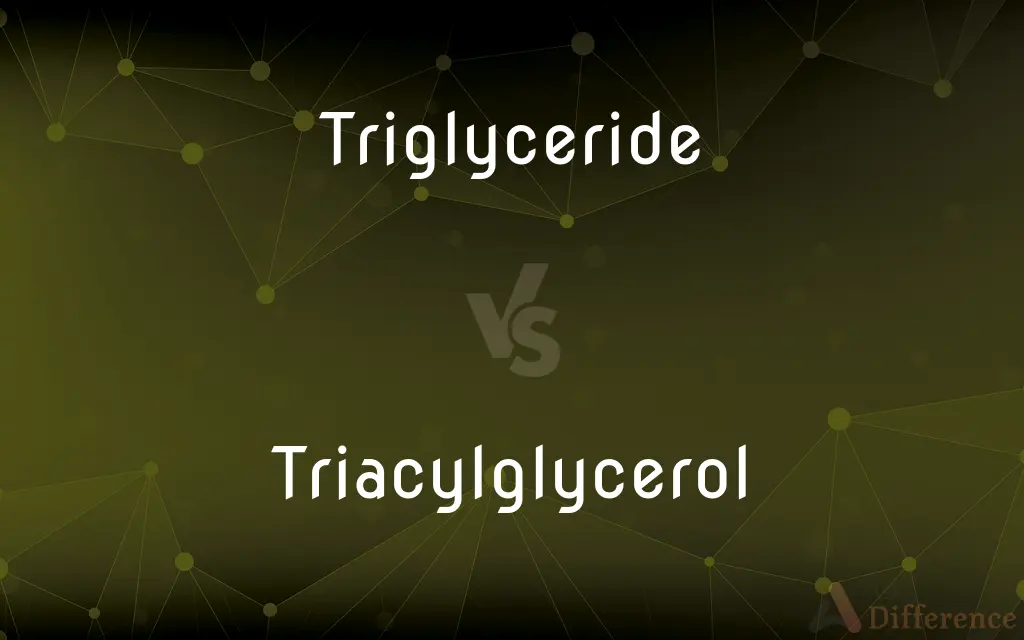Triglyceride vs. Triacylglycerol — What's the Difference?
By Tayyaba Rehman — Updated on October 16, 2023
Triglyceride and triacylglycerol refer to the same molecule: a glycerol backbone bonded to three fatty acid chains. The terms are used interchangeably, with "triglyceride" being more common in medical contexts.

Difference Between Triglyceride and Triacylglycerol
Table of Contents
ADVERTISEMENT
Key Differences
A triglyceride is a type of lipid molecule that plays a vital role in metabolism as an energy source and transporter of dietary fat. It consists of one glycerol molecule attached to three fatty acid chains. On the other hand, triacylglycerol is essentially the same molecule, but the term emphasizes the three acyl (fatty acid) groups attached to glycerol.
In the realm of biochemistry, when discussing the molecular structure and chemical properties, the term triacylglycerol is often preferred. This term precisely denotes the three fatty acid chains (acyl groups) attached to the glycerol molecule. However, in medical and clinical settings, the word triglyceride is more commonly used. This is especially true when referring to blood lipid levels or dietary fats.
Both triglycerides and triacylglycerols are stored in fat cells and can be broken down to provide energy for the body. They are the main constituents of body fat in humans and other animals, as well as vegetable fat. Meanwhile, in academic and research publications, especially in lipid chemistry, the term triacylglycerol may be favored for its specificity.
Interestingly, while triglyceride has become the household term, especially when people discuss cholesterol and heart health, triacylglycerol remains an important term in scientific literature. Both terms underscore the significance of these molecules in biology, nutrition, and medicine.
Comparison Chart
Definition
A lipid molecule with three fatty acid chains
A lipid with three acyl groups on glycerol
ADVERTISEMENT
Common Usage
Medical and dietary contexts
Scientific and biochemistry contexts
Composition
One glycerol and three fatty acids
Glycerol backbone with three acyl chains
Role in Body
Energy source and transporter of dietary fat
Main constituent of body and vegetable fat
Contextual Preference
Cholesterol and heart health discussions
Academic and research publications
Compare with Definitions
Triglyceride
Main form of fat stored in the body.
Excess calories are converted to triglycerides and stored in fat cells.
Triacylglycerol
A lipid molecule with three acyl groups attached to glycerol.
The structural difference between fats and oils lies in their triacylglycerol composition.
Triglyceride
A dietary fat found in food.
Avocado contains healthy triglycerides.
Triacylglycerol
A molecule studied in lipid chemistry.
His research focuses on the properties of different triacylglycerols.
Triglyceride
A molecule used to check heart health in blood tests.
She got her triglyceride levels tested during her health checkup.
Triacylglycerol
A molecule that can undergo hydrolysis.
During digestion, enzymes break down triacylglycerol into glycerol and fatty acids.
Triglyceride
A lipid molecule composed of glycerol and three fatty acids.
High blood levels of triglycerides can increase heart disease risk.
Triacylglycerol
The scientific term for body and vegetable fats.
Sunflower oil is rich in unsaturated triacylglycerols.
Triglyceride
A substance that can be either saturated or unsaturated.
Saturated triglycerides are solid at room temperature.
Triacylglycerol
An energy reservoir for organisms.
When food intake exceeds energy expenditure, excess energy is stored as triacylglycerol in adipose tissue.
Triglyceride
A triglyceride (TG, triacylglycerol, TAG, or triacylglyceride) is an ester derived from glycerol and three fatty acids (from tri- and glyceride). Triglycerides are the main constituents of body fat in humans and other vertebrates, as well as vegetable fat.
Triacylglycerol
Triglyceride.
Triglyceride
An ester formed from glycerol and three fatty acid groups. Triglycerides are the main constituents of natural fats and oils.
Triacylglycerol
(organic chemistry) triglyceride
Triglyceride
Any of a class of compounds that consist of an ester of glycerol with three fatty acids and that are the chief constituents of fats and oils.
Triglyceride
(organic chemistry) A lipid, an ester of glycerol and three fatty acids (the same or different); the major constituent of animal and vegetable fats
Triglyceride
A glyceride formed by the replacement of three hydrogen atoms in glycerin by acid radicals.
Triglyceride
Glyceride occurring naturally in animal and vegetable tissues; it consists of three individual fatty acids bound together in a single large molecule; an important energy source forming much of the fat stored by the body
Common Curiosities
Are high blood triglyceride levels a health concern?
Yes, high levels can increase the risk of heart disease.
Which term is more specific to the molecule's structure?
Triacylglycerol emphasizes its three acyl groups.
What is the backbone of a triglyceride molecule?
Glycerol.
Which term is more common in medical settings?
Triglyceride is more commonly used in medical contexts.
What is the primary function of triacylglycerol in the body?
It serves as an energy storage molecule.
What is the significance of triacylglycerol in plants?
It's a main component of vegetable oils.
Can triglycerides be found in our diet?
Yes, they are a primary form of dietary fat.
Are triglyceride and triacylglycerol the same?
Yes, they refer to the same molecule but are used in different contexts.
In which cells are triacylglycerols primarily stored?
They are mainly stored in adipose (fat) cells.
Are all triacylglycerols the same?
No, they can vary based on the fatty acids attached.
Is triglyceride a type of cholesterol?
No, but it is a type of lipid often discussed alongside cholesterol.
Are triglyceride levels tested in routine blood work?
Yes, they are often part of lipid profile tests.
Is the term triacylglycerol used in research?
Yes, especially in lipid chemistry and biochemistry.
Can enzymes break down triacylglycerol?
Yes, during digestion, it's broken down into glycerol and fatty acids.
What happens to excess triglycerides in the body?
They are stored in fat cells for future energy needs.
Share Your Discovery

Previous Comparison
Motor vs. Rotor
Next Comparison
Intrigue vs. MysteryAuthor Spotlight
Written by
Tayyaba RehmanTayyaba Rehman is a distinguished writer, currently serving as a primary contributor to askdifference.com. As a researcher in semantics and etymology, Tayyaba's passion for the complexity of languages and their distinctions has found a perfect home on the platform. Tayyaba delves into the intricacies of language, distinguishing between commonly confused words and phrases, thereby providing clarity for readers worldwide.














































